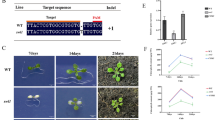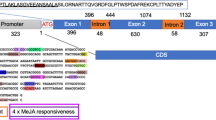Abstract
ASYMMETRIC LEAVES2-LIKE16 gene of Arabidopsis is a member of the ASYMMETRIC LEAVES2 (AS2)/LATERAL ORGAN BOUNDARIES (LOB) domain gene family. Current reports have indicated that overexpression of ASL16 induces lateral root formation in the absence of ARF7 and ARF19; whereas lateral root formation is severely reduced in the arf 7 and arf 19 double knockout mutants. Antisense mRNA has testified to be a useful tool to inhibit the expression of specific genes in plants; more significantly, it is specific in the sense that only the mRNA level of the desired protein being changed, while other members of the gene family remain unaffected. To further explore ASL16 function in lateral root growth and development, we introduced an antisense-expression construct of the ASL16 gene to Arabidopsis (Col-0); and acquired some 35S:ASL16 Arabidopsis plants. With 11 day after germination (DAG), many lateral roots in wild-type seedlings were well developed, whereas a few lateral roots in these antisense 35S:ASL16 seedlings were produced. However, with 5, 8 and 16 DAG, the lateral roots in these transgenic seedlings were not distinct with those of wild-type plants. A series of data indicate that primary root formation of these antisense 35S:ASL16 plants was not affected; whereas their lateral root formation was severely inhibited.
Similar content being viewed by others
Abbreviations
- RT-PCR:
-
reverse transcription PCR
- WT:
-
wild type
- M:
-
marker
- DAG:
-
day after germination
References
Andersson J., Walters R.G., Horton P. & Jansson S. 2001. Antisense inhibition of the photosynthetic antenna proteins CP29 and CP26: implications for the mechanism of protective energy dissipation. Plant Cell 13: 1193–1204.
Casimiro I., Marchant A., Bhalerao R.P., Beeckman T., Dhooge S., Swarup R., Graham N., Inze D., Sandberg G., Casero P.J. & Bennett M. 2001. Auxin transport promotes Arabidopsis lateral root initiation. Plant Cell 13: 843–852.
Chalfun-Junior A., Franken J., Mes J.J., Marsch-Martinez N., Pereira A. & Angenent G. C. 2005. ASYMMETRIC LEAVES2-LIKE1 gene, a member of the AS2/LOB family, controls proximaldistal patterning in Arabidopsis petals. Plant Mol. Biol. 57: 559–575.
Dubrovsky J.G., Rost T.L., Colon-Carmona A. & Doerner P. 2001. Early primordium morphogenesis during lateral root initiation in Arabidopsis thaliana. Planta 214: 30–36.
Fukaki H., Okushima Y. & Tasaka M. 2007. Auxin-mediated lateral root formation in higher plants. Int. Rev. Cytol. 256: 111–137.
Ganeteg U., Strand A., Gustafsson P. & Jansson S. 2001. Theroperties of the chlorophyll a/b-binding proteins Lhca2 and Lhca3 studied in vivo using antisense inhibition. Plant Physiol. 127: 150–158.
Hirota A., Kato T., Fukaki H., Aida M. & Tasaka M. 2007. The auxin-regulated AP2/EREBP gene PUCHI Is required for morphogenesis in the early lateral root primordium of Arabidopsis. Plant Cell 19: 2156–2168.
Husbands A., Bell E.M., Shuai B., Smith H.M.S. & Springer P.S. 2007. LATERAL ORGAN BOUNDARIES defines a new family of DNA-binding transcription factors and can interact with specific bHLH proteins. Nucleic Acids Res. 35: 6663–6671.
Inukai Y., Sakamoto T., Ueguchi-Tanaka M., Shibata Y., Gomi K., Umemura I., Hasegawa Y., Ashikari M., Kitano H. & Mat-suoka M. 2001. Crown rootlessl, which is essential for crown root formation in rice, is a target of an AUXIN RESPONSE FACTOR in auxin signaling. Plant Cell 17: 1387–1396.
Iwakawa H., Iwasaki M., Kojima S. et al. 2007. Expression of the ASYMMETRIC LEAVES2 gene in the adaxial domain of Arabidopsis leaves represses cell proliferation in this domain and is critical for the development of properly expanded leaves. Plant J. 51: 173–184.
Iwakawa H., Ueno Y., Semiarti E., Onouchi H., Kojima S., Tsukaya H., Hasebe M., Soma T., Ikezaki M., Machida C. & Machida Y. 2002. The ASYMMETRIC LEAVES2 gene of Arabidopsis thaliana, required for formation of a symmetric flat leaf lamina, encodes a member of a novel family of proteins characterized by cysteine repeats and a leucine zipper. Plant Cell Physiol. 43: 467–478.
Laskowski M.J., Williams M.E., Nusbaum H.C. & Sussex I.M. 1995. Formation of lateral root meristems is a two-stage process. Development 121: 3303–3310.
Lin W.C., Shuai B. & Springer P.S. 2003. The Arabidopsis LATERAL ORGAN BOUNDARIES-domain gene ASYMMETRIC LEAVES2 functions in the repression of KNOX gene expression and in adaxial-abaxial patterning. Plant Cell 15: 2241–2252.
Liscum E. & Reed J.W. 2002. Genetics of Aux/IAA and ARF action in plant growth and development. Plant Mol. Biol. 49: 387–400.
Liu H., Wang S., Yu X., Yu J., He X., Zhang S., Shou H. & Wu P. 2005. ARL1, a LOB-domain protein required for adventitious root formation in rice. Plant J. 43: 47–56.
Malamy J.E. & Benfey P.N. 1997. Organization and cell differentiation in lateral roots of Arabidopsis thaliana. Development 124: 33–44.
McHale N.A. & Koning R.E. 2004. PHANTASTICA Regulates development of the adaxial mesophyll in Nicotiana leaves. Plant Cell 16: 1251–1262.
Meng L.S., Ding W.Q., Hu X. & Wang C.Y. 2009a. Transformation of PttKNl gene to Cockscomb. Acta Physiol. Plant. 31: 683–691.
Meng L.S., Song J.P., Sun S.B. & Wang C.Y. 2009b. The ectopic expression of PttKNl gene causes pleiotropic alternation of morphology in transgenic carnation (Dianthus caryophyllus L.). Acta Physiol. Plant. 31: 1155–1164.
Meng L.S., Wang Y.B., Yao S.Q. & Liu A. 2015a. Arabidopsis AINTEGUMENTA (ANT) mediates salt tolerance by trans-repressing SCABP8. J. Cell Sci. 128: 2919–2927.
Meng L.S., Wang Z.B., Yao S.Q. & Liu A. 2015b. The ARF2-ANT-COR15A gene cascade regulates ABA signaling-mediated resistance of large seeds to drought in Arabidopsis. J. Cell Sci. 128: 3922–3932.
Meng L.S. 2015. Transcription coactivator Arabidopsis ANGUS-TIFOLIA3 modulates anthocyanin accumulation and light-induced root elongation through transrepression of constitutive photomorphogenicl. Plant Cell Environ. 38: 838–851.
Meng L.S. & Yao S.Q. 2015. Transcription co-activator Arabidopsis ANGUSTIFOLIA3 (AN3) regulates water-use efficiency and drought tolerance by modulating stomatal density and improving root architecture by the transrepression of YODA (YDA). Plant Biotech. J. 13: 893–902.
Okushima Y., Fukaki H., Onoda M., Theologis A. & Tasaka M. 2007. ARF7 and ARF 19 regulate lateral root formation via direct activation of LBD/ASL genes in Arabidopsis. Plant Cell 19: 118–130.
Shuai B., Reynaga-Peña C.G. & Springer P.S. 2002. The LATERAL ORGAN BOUNDARIES gene defines a novel, plant-specific gene family. Plant Physiol. 129: 747–761.
Song J.P., Liu D.H., Wang Y.B. & Shi Y.N. 2016. Formation of radial symmetric needle-like rosette leaves in Arabidopsis. Biologia 70: 1606–1613
Sun S.B., Song J.P. & Meng L.S. 2012. ASYMMETRIC LEAVES2 gene, a member of AS2/LOB family of Arabidopsis causes an abaxializing leaves in transgenic Cockscomb plants. Mol. Biol. Rep. 39: 4927–4935.
Tiwari S.B., Hagen G. & Guilfoyle T.J. 2004. Aux/IAAproteins contain a potent transcriptional repression domain. Plant Cell 16: 533–543.
Ulmasov T., Hagen G. & Guilfoyle T.J. 1999. Activation and repression of transcription by auxin-response factors. Proc. Natl. Acad. Sci. USA 96: 5844–5849.
Wang S., Tiwari S.B., Hagen G. & Guilfoyle T.J. 2005. AUXIN RESPONSE FACTOR7 restores the expression of auxinresponsive genes in mutant Arabidopsis leaf mesophyll protoplasts. Plant Cell 17: 1979–1993.
Woodward A.W. & Bartel B. 2005. Auxin: regulation, action and interaction. Ann. Bot. 95: 707–735.
Xu L., Xu Y., Dong A., Sun Y., Pi L., Xu Y. & Huang H. 2003. Novel asl and as2 defects in leaf adaxial-abaxial polarity reveal the requirement for ASYMMETRIC LEAVES1 and 2 and ERECTA functions in specifying adaxial identity. Development 130: 4097–4107.
Author information
Authors and Affiliations
Corresponding authors
Rights and permissions
About this article
Cite this article
Meng, LS., Bizhu, H., Cao, XY. et al. ASL16 gene, a member of AS2/LOB family, is essential for lateral root formation in Arabidopsis. Biologia 71, 1009–1016 (2016). https://doi.org/10.1515/biolog-2016-0120
Received:
Accepted:
Published:
Issue Date:
DOI: https://doi.org/10.1515/biolog-2016-0120




